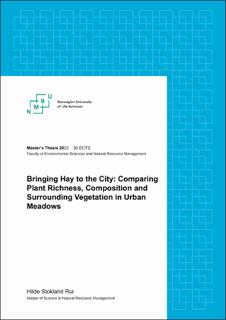| dc.description.abstract | Urban flower meadows may benefit urban biodiversity and function, but it is not yet clear which means for establishing these meadows provide the best results. In this study, we used dry hay as a seed source, establishing three urban flower meadows (receptor sites) in the city of Porsgrunn. The seed-containing hay derived from two local hay meadows (donor sites). By comparing species richness and species composition of vascular plants between the two donor sites and the three receptor sites, I evaluated the restoration success of the critical first year after establishment. Lastly, I investigated whether hay cover and surrounding vegetation had an impact on the species richness and composition at site.
Vegetation analyses of 10 plots were performed on each of the five sites. The cover of vascular plant species, hay litter and four vegetation layers were visually estimated. Surrounding the receptor meadows, the closest distance of each vascular plant species was recorded in a spiral of 100 m radius.
T-tests, ANOVA and ordination methods were used to detect differences in vegetation layers, species richness, hay litter cover and species composition. GLMs were used to detect potential effects of hay litter cover and surrounding species of the receptor meadows. Lastly, I used four parameters to evaluate restoration success of the three receptor meadows.
Species composition was significantly different between donor sites and receptor sites, and donor sites contained a significantly higher number of meadow species than the receptor sites. Yet, many meadow species were observed in the new meadows, and 19 meadow species were most likely successfully transferred from donated hay. The three new meadows, Sundjordet, Helleberget and Lysthusåsen, received a success score of medium, low, and very low, respectively. More hay litter at the receptor sites led to an overall higher number of meadow species, indicating that more hay could have been used. A species distance to a receptor meadow was negatively correlated with its abundance in the receptor meadow, suggesting that a considerable amount of dispersal from pioneer species occurred from the surroundings.
My findings show that it is not possible to acquire an urban hay meadow within one year. Nevertheless, many meadow species can be transferred using dry hay, demonstrating that this establishment technique works well for creating diverse flower meadows in an urban setting. Such meadows may contribute to increasing plant and insect diversity in the city as well as being an incentive for maintaining current hay meadows on the countryside. | |
